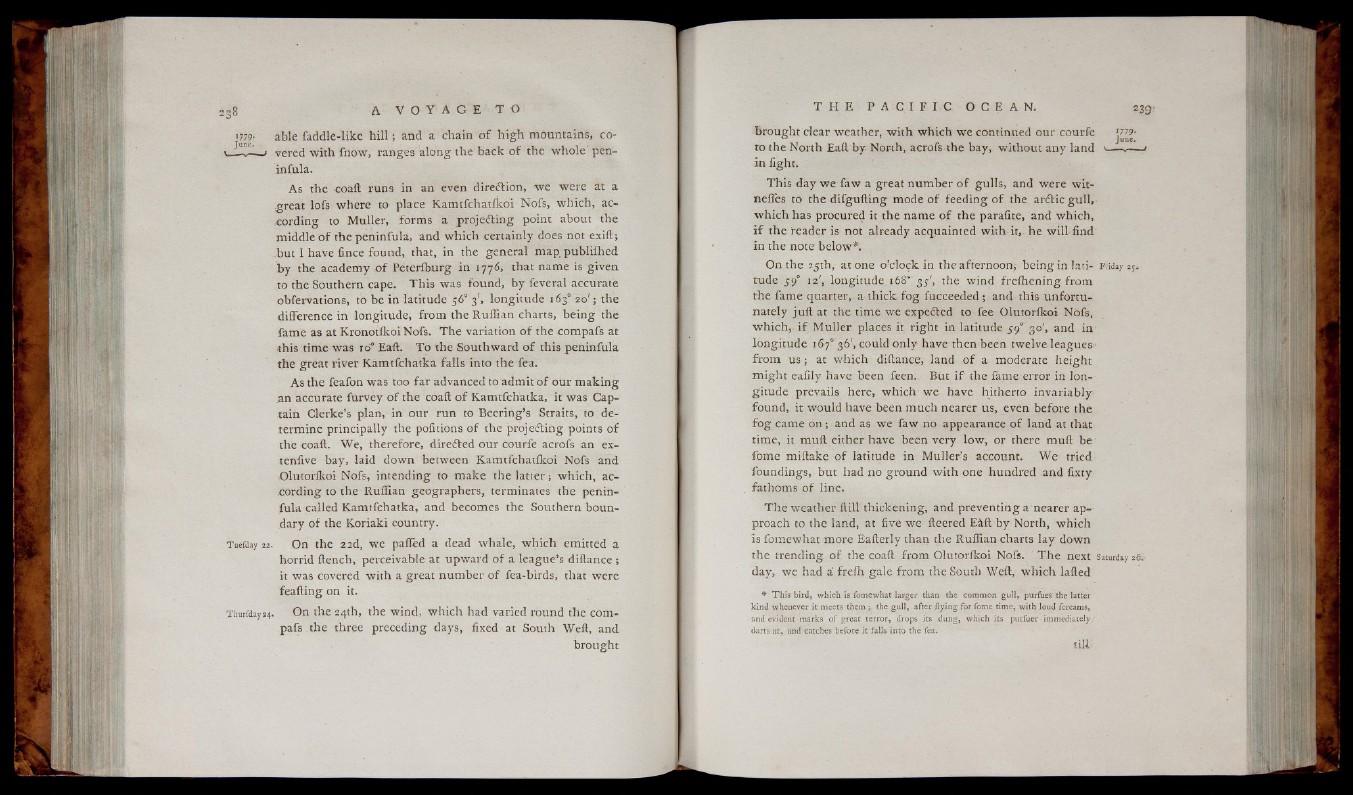
1779*
Jun e .
Tuefday 22.
T h u r fd a y ,24-
able faddle-like h i l l ; and a chain o f h ig h mountains, covered
with fnow, ranges along the back o f the whole peninfula.
As the coaft runs in an even direction, w e were at a
g rea t lofs where to place Kamtfchatikoi Nofs, which, according
to Muller, forms a projecting point about the
middle o f the peninfula, and which certainly does not exift;
but I have fince found, that, in the general m a g publiihed
b y the academy o f Peterfburg in 1776, that name is given
to the Southern cape. T his was found, by feveral accurate
obfervations, to be in la titu d e '56° 3', longitude 163° 20'; the
difference in longitude, from the Ruffian charts, be in g the
fame as at Kronotfkoi Nofs. T he variation o f the compafs at
this time was 10° Eaft. T o the Southward o f this peninfula
the great river Kamtfchatka falls into the Tea.
As the feafon was too fa r advanced to admit o f our m a k in g
jan accurate furvey o f the coaft o f Kamtfchatka, it was Captain
Clerke’s plan, in our run to Beering’s Straits, to determine
principally the pofitions o f the projecting points o f
the coaft. We, therefore, directed our Courfe acrofs an ex-
tenfive bay, laid down between Kamtfchatikoi Nofs and
.Olutorikoi Nofs, intending to make the la tte r ; which, accord
ing to the Ruffian geographers, terminates the peninfula
called Kamtfchatka, and becomes the Southern boundary
o f the Koriaki country.
On the 2 2d, we palled a dead whale, w h ich emitted a
horrid ftench, perceivable at upward o f a league’ s diftance ;
it was covered with a great number o f fea-birds, that were
feafting on it.
On the 24th, the wind, which had varied round the compafs
the three preceding days, fixed at South Weft, and
brought
Brought d e a r weather, w ith w hich we continued our courfe \Ti9-
- June*
to the North Eaft by. North, acrofs the bay, without any land —f
in fight.
This day w eT aw a great number o f gu lls, and were wit-
nefles to the difgu ftin g mode o f feeding o f the arCtic gu ll,
w h ich has procured it the name o f the parafite, and which,
i f the reader is not already acquainted with-it, he w ill find
in the note below*.
On the 25th, a to n e o’clock in theafternoon, being in lati- Friday 25.
rude 59° 12', longitude 168' 33', the wind freffiening from
the fame quarter, a thick fo g fucceeded and this unfortunately
juft at the time we expedted to fee Olutorikoi Nofs,
w h ich , i f Mulle r places it right in latitude 59° 30', and in
longitude 167° 36', could only have then been twelve leagues-
from u s ; at which diftance, land o f a moderate height
m igh t eafily have been feen. But i f the fame error in longitude
prevails here, which we have hitherto invariably-
found, it would have been much nearer us, even before the
fo g came o n ; and as we faw no appearance o f land at that
time, it muft either have been very low, or there muft be
fome miftake o f latitude in Muller’s account. W e tried
foundings, but had no ground with one hundred and fixty
fathoms o f line.
T h e weather ftill thickening; and preventing a nearer ap~-
proach to the land, at five we fleered Eaft by North, which
is fomewhat more Eafterly than the Ruffian charts la y down
the trending o f the coaft from Olutorikoi Nofs. T h e next Saturday 26.-
day, w e had a frefh gale from the South Weft, w h ich lafted
* ’ This bird, which is fomewhat larger than the common gull, purfues’ the latter
kind whenever it meets them j, the gull, after -flying for fome time, with loud /creams,
and evident marks of great terror, drops its dung, which its purfuer immediately.,
darts at, and catches before it falls into the fea.
till: